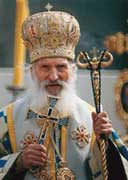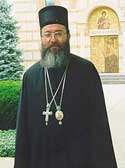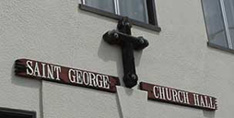
History
|
Serbian Orthodoxy The Serbian Orthodox Church is an autocephalous, or ecclesiastically
independent, member of the Orthodox communion, located primarily
in Serbia, Montenegro, Bosnia and Herzegovina and Croatia. Since
many Serbs have immigrated to foreign countries, now there are now
many Serbian Orthodox communities on all continents.
The restoration of the Patriarchate was of great importance for
the Serbs because it helped the spiritual unification of all Serbs
in the Turkish Empire. After consequent Serbian uprisals against
the Turkish occupators in which the Church had a leading role, the
Turks abolished the Patriarchate once again in 1766. The Church
remained once more under the jurisdiction of the Ecumenical Patriarch
of Constantinople. This period of so called "Phanariots"
was a period of great spiritual decline because the Greek bishops
had very little understanding for their Serbian flock. This was
also the period when great number of Christians converted to Islam
to avoid severe taxes imposed by the Turks in retaliation for uprisings
and continued resistance. Many Serbs with their hierarchs migrated
to Southern Hungary where they had been granted the Church autonomy.
The seat of the archbishops was moved from Pec to Karlovci. The
Serbian Orthodox Church finally regained its independance and became
autocephalous in 1879, the year after the recognition by the Great
Powers of Serbia as an independent state. After World War I all
the Serbs were united under one ecclesiastical authority, and the
Patriarchate was reestablished in 1920 with election of Patriarch
Dimitry, the Patriarch's full title being "Archbishop of Pec,
Metropolitan of Belgrade and Karlovci, and Patriarch of the Serbs."
During the Second World War the Serbian Orthodox Church passed through
severe trials in which many bishops, priests and about 700.000 lay
Orthodox Christians were killed by Croatian and Moslem fascists.
Hundreds of churches were completely destroyed or desecrated. After
the Second World War the Church experienced new trials under the
communists who prohibited teaching of religion in schools, confiscated
the property of the Church and using various overt and covert means
of persecution in order to diminish the influence the Church had
among the people. It was only after 1989 that the position of the
Church has became tolerable, although the Church estastes have not
yet been returned to their lawful owners. |
|||
|
|
The History of the St.George Church Begun humbly, then, by a small group of men and women whose main task was in the field of Serbian Orthodox Education. Fostering learning and cultural appreciation, they organized a local chapter called, "Education," affiliated with the central office in Sarajevo, Bosnia. |
||
| On December 20, 1916, this
local chapter, "Prosveta" convened for the first time at
4095 San Pablo Avenue, Oakland, California and elected an executive
board:
Milo Glogovac: President |
|||
| On November 22, 1924 was
argued to name and place the newly0formed parish under the heavenly
protection of Saint George, the Great Martyr. The brilliant flame
of Serbian Orthodoxy brightened the dreary days ahead. With economic
depression on the horizon, the times were getting together and money
scarcer, but our people knew there was more to life. Crowing their
sacrificial efforts was the great day of Dedication, the feast of
St. Nicolas, December 19, 1926, when Bishop Mardarije, the first Serbian
Hierarch in America, consecrated the Church of Saint George to the
glory of the All- Holy and Undivided Trinity Form that time till now St. George Serbian Orthodox Church was serve like a shelter for all Serbian people that came to this area. This year on November 6, we are celebrating the 75th anniversary of the church. |
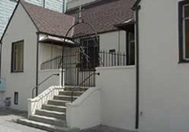
The Main Entance form the Oak Street |
||
Home | General Information | History | Events and Facilities | Directions
The Church Members

Parish Priest
V. Rev. Sava BosanacChurch Board
President:
Michael Kakarigi
Vice President:
George Banovich
Secretary:
George Cavic
Financial Secretary:
Don Nelson
Auditors:
Mellie Kakarigi
George Sekulich
SAm Vukicevich
Tutor:
Ilija Djukic
Sunday School Teacher:
Mileva Cavic
St. George Choir
President:
Steve Kakarigi since 1956
On Jun 2, 2001 we are celebrating the 45th anniversary of the church's
choir
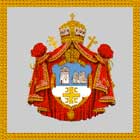
Serbian Amblem

Serbian Flag
SONG TO HOLY SERBIA
O Serbia mother dear,May you always joyful be,
Your children love you
And to God they pray for you.
Country of our forefathers,
Braves and saints
For Holy Cross noble martyrs,
And the freedom fighters.
Grave to grave, holy ground,
There peacefully rest Serbian slaves,
And all altar next to altar, legacies,
Monasteries built by our kings.
On Kosovo Gracanica,
In mountain Studenica,
By Morava Ravanica’
In Krusevac Lazarica.
And all battlefield to battlefield,
Before and after Vidovdan,
All sprinkled with blood
And by tears washed.
There Kosovo sadly stands,
Five centuries of slavery counts,
A memorial of glory and bravery,
And of disunity and treachery.
Do not fear mother dear,
God will grant you joy again,
And amongst nations
The greatest glory
Bishop Nikolai
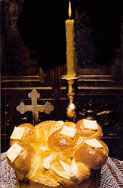
Last updated on 04.20.2001 || contact Webmaster
